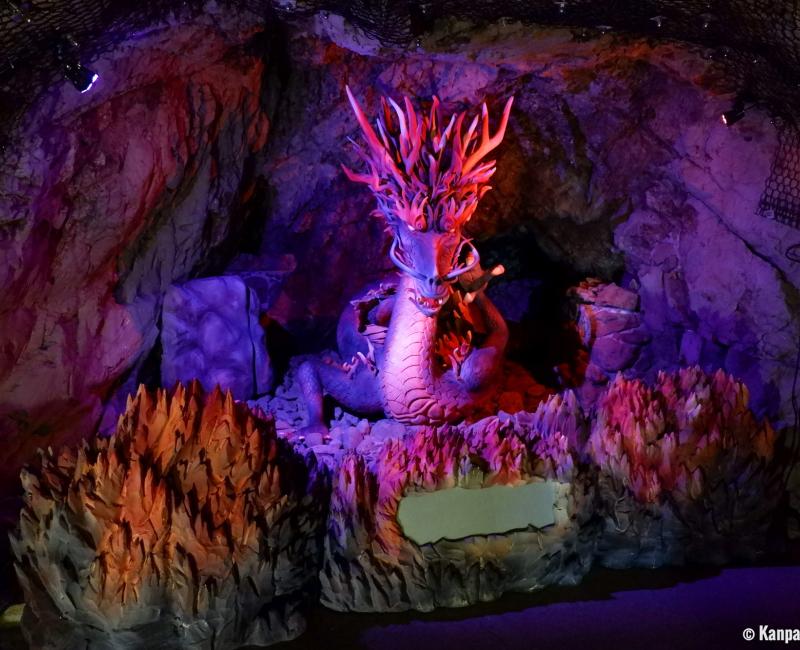Enoshima Southern Coast
At the Island’s Origins
Enoshima southern coast is a coastline of steep sea cliffs located at the south-westernmost part of the island, facing the Pacific Ocean. Thanks to an easy pedestrian path, this area opens on new aspects of Enoshima, more natural and less touristic. Inhabitants come here at low tide to fish and enjoy the sunlight. Several landscapes and spiritual sites are also to be discovered.
Enoshima southern area begins just after the famous Samuel Cocking Garden and is a lot quieter and relaxing than the path at the entrance of Enoshima. Visitors are not so numerous to continue the exploration to the opposite side of the island.
Past the Sea Candle Observatory, the way called Oiwaya Michi, an ancient pilgrimage route from Hetsunomiya main shrine, leads to Iwaya Caves. In the old days, many pilgrims walked this path searching for "illumination" and the gods’ protection. Nowadays, the path is essentially lined with restaurants and cafés installed in old traditional houses. A little bit further stands a first attraction: Yama-futatsu valley, from where one can see the sea between two imposing cliffs.

Okutsunomiya Shrine
Further down the way, an old stone torii ⛩️ gate opens on the marvelous Okutsunomiya Shrine. The legend has it that Minamoto no Yoritomo, the founder of Kamakura shogunate in 1185, has offered the gate to the island. This shrine is the first spiritual site elevated on Enoshima. There is also an original stone statue in the shape of a turtle (named Kame-ishi), and a "strength stone" (Chikara-ishi), a heavy stone that was donated by the strongest man in Edo period (1603 - 1868). The surroundings of Okutsunomiya are verdant, especially with cherry trees 🌸 and hydrangeas that offer a flowery landscape in spring.
A little bit further on the right, the small Wadatsumi-no-miya shrine worships the dragon from which the island was born. For couples, a detour by Ryuren No Kane hill is the occasion to ring the dragon’s bell of love, before going down along the coast, by a long series of stairways.
On the seaside, the landscape is totally different. The lush greeneries disappear for steep cliffs carved by the tides. On a clear weather day, it is even possible to see Mount Fuji 🗻, visible in the background when looking toward Honshu island from the embarkation port for Benten-maru boats.

Iwaya Caves
Then a narrow path carved in the rock leads to the two Iwaya Caves. They were immerged in the sea in the past, but several earthquakes forced them to the surface, and they are now in the open.
The first cave is the largest. It is accessible by steps going down in a long and narrow tunnel at the end of which an attendant hands a candle to light the way to the darker parts of the cave. This first tunnel is ornamented with Buddhist statues. At some point, a fork opens in the cave:
- The left branch is 152 meters long and shelters other spiritual representations of the island,
- The right branch, shorter, shelters a statue of the sun goddess Amaterasu, that is said to be a direct ancestor of the first emperor of Japan Jinmu.
This visit is not recommended for claustrophobic persons as some parts of the cave have very low ceilings.
Then on the open air, a footbridge runs alongside the cliff to the second Iwaya Cave. It is characterized by a majestic statue of the dragon. According to the legend, it used to terrorize the area until the goddess Benten tamed it. The dragon then redeemed itself and became the protective deity of local fishermen. People clapping hands in front of its statue are rewarded with sparkling lights and the sound of thunder.
The popularity of Iwaya Caves lies as much as in their pleasant location on the seaside than in the rock formations. We recommend this visit for the variety of landscapes it offers a couple of minutes’ walk from Enoshima’s touristic center.

